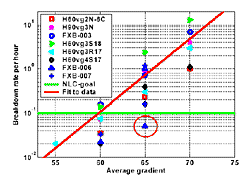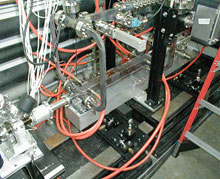Research
Highlights...
|
|
|
PPPL physicist Hutch Neilson, Project Head
of NCSX. |
|
 |
| Number 153 |
March 8, 2004 |
Just say ‘no' to adenovirus
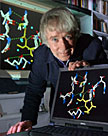 |
| Walter Mangel |
Biologists at Brookhaven Lab are looking for ways to “Just Say NO” to human adenovirus, the culprit behind some forms of pink eye, cold epidemics, disabling diarrhea, and opportunistic infections. Their method: Enlist the infected cells' own arsenal of nitric oxide (NO) to destroy a key viral enzyme. The team has shown that NO, a chemical made by many normal cells, inhibits adenovirus protease, an enzyme that cleaves scaffolding proteins to complete the process of virus maturation. Adenovirus particles treated with NO were much less infectious. The findings may one day lead to easily administered treatments that boost NO production to battle adenovirus.
[Karen McNulty Walsh, 631/344-8350;
kmcnulty@bnl.gov]
|
|
Counting atoms that aren't there, in stars that no longer exist
Researchers at DOE's Argonne National Laboratory have reached for the stars – and seen what's inside. Argonne scientists examined stardust from a meteorite and found remnants of now-extinct technetium atoms made in stars that lived and died before the solar system formed. Each tiny grain carries a chemical record of nuclear reactions in its parent star. The work was made possible by a one-of-a-kind instrument at Argonne called CHARISMA. It will later be used to examine samples of the solar wind captured by Genesis as well as dust grains from a comet's tail collected in the Stardust mission.
[Catherine Foster, 630/252-5580;
cfoster@anl.gov]
|
|
Pentaquark: Strongest confirmation to date
Research carried out at DOE's Jefferson Lab and published in January provides the best evidence to date of the pentaquark's existence. Ordinary matter is composed of particles that contain quarks in bunches of two or three, while the pentaquark particle contains five quarks. It's difficult to detect, because it decays into other particles so quickly after forming. By directing a photon beam at a hydrogen target, CLAS (CEBAF Large Acceptance Spectrometer) Collaboration physicists were able to account for each of the expected particles from the reaction that signals the production and decay of the pentaquark, providing the most sensitive detection of the pentaquark yet.
[Kandice Carter, 757/269-7444;
kcarter@jlab.org]
|
|
First mice born in ORNL's new house
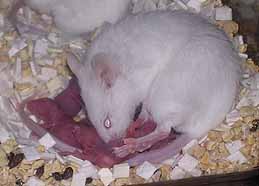 |
| The first litter of mice in the new Russell Lab. |
The first litter of mice in ORNL's new mouse house, the William L. and Liane B. Russell Laboratory for Comparative and Functional Genomics, was born Feb. 21. The mouse “pups” were re-derived through the implantation of frozen two-cell embryos into mother mice. The result is the beginning of a new, specific-pathogen free mouse population free of common viruses, bacteria and parasites. This year approximately six to ten thousand mice will be re-derived in the new facility. The new Russell Lab is also a barrier facility, which means there are several levels of protection against entry by outside pathogens.
[Bill Cabage, 865/574-4399;
cabagewh@ornl.gov]
|
|
|
|
PPPL's Neilson: Star Generator
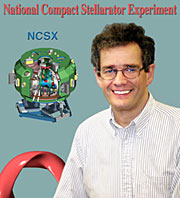 |
| PPPL physicist Hutch Neilson, Project Head of NCSX. |
For more than two decades, Hutch Neilson has been fascinated by the physics of a class of fusion devices called stellarators. Now Neilson, a physicist at DOE's Princeton Plasma Physics Laboratory (PPPL), is at the helm of the National Compact Stellarator Experiment (NCSX).
NCSX is planned as the centerpiece of the U.S. effort to develop the physics and determine the attractiveness of the compact stellarator as the basis for a fusion power reactor. The NCSX, which is now in the design stages, will be built at PPPL in partnership with Oak Ridge National Laboratory (ORNL). The project officially started last year, with operations scheduled to begin in 2008.
“What interests me about stellarator physics is the three-dimensional structure of the magnetic field and the plasma shape,” said Neilson, NCSX Project Head. “The cross-sectional shape of a three-dimensional plasma depends on where the torus is sliced, while the cross-sectional shape of a tokamak - another fusion machine configuration that is a two-dimensional torus - is always the same. Consequently, stellarator physicists have three degrees of freedom to tailor the plasma shape for good performance. There are only two degrees of freedom in a tokamak.” Plasmas are hot, ionized gases used as the fuel for fusion devices. The NCSX will help fusion researchers understand the physics of three-dimensional magnetized plasmas.
Neilson, who joined PPPL in 1996, became interested in stellarators in the early 1980s while at ORNL. He noted that stellarators were the first experimental fusion machines at PPPL when the Laboratory was established in the 1950s. PPPL founder Lyman Spitzer, Jr., coined the phrase “stellarator,” which means star generator. Dramatic advances in magnetic confinement physics and computational capabilities have led researchers to return to this new version of the concept called the compact stellarator.
“I think it is fitting that the Laboratory, after making historic advances with tokamaks, has turned to the task of expanding our understanding of toroidal configurations to find the best solution for magnetic fusion reactors,” Neilson said. “The basic conditions for good magnetic confinement are a toroidal geometry and a magnetic field that twists around helically on magnetic surfaces. A stellarator can create those conditions readily.”
Submitted by DOE's
Princeton Plasma Physics Laboratory
|
|




